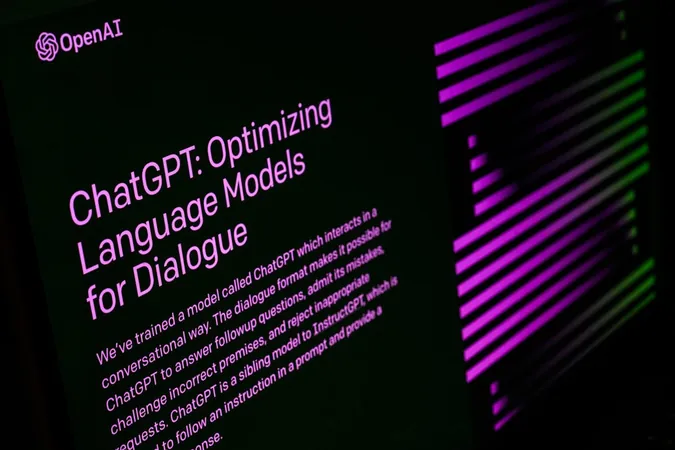
ChatGPT: The AI Chatbot Revolutionizing Communication
2025-04-21
Author: Li
Since its debut in November 2022, ChatGPT, the groundbreaking AI chatbot developed by OpenAI, has become a global sensation, amassing an impressive 300 million weekly active users. The platform, initially designed to enhance productivity by crafting essays and coding, has rapidly evolved into a multifaceted powerhouse transforming how we interact with AI.
2024 marked a pivotal year for OpenAI, featuring strategic partnerships like the one with Apple for their generative AI initiative, Apple Intelligence. New releases, including GPT-4o with voice capabilities and an eagerly awaited text-to-video model named Sora, fueled its trajectory.
However, OpenAI's journey hasn't been without challenges. It faced high-profile departures from key figures, including co-founder Ilya Sutskever and CTO Mira Murati. Legal hurdles loomed over the company, with lawsuits claiming copyright infringement and Elon Musk pushing for a halt in OpenAI's shift to a for-profit model.
In 2025, OpenAI is grappling with rising competition from Chinese counterparts, like DeepSeek. Amid these pressures, the organization is fostering connections with Washington while gearing up for one of the largest funding rounds ever in tech history.
Latest Innovations and Features
OpenAI continues to leap ahead in tech, including recent updates such as a new API feature called Flex processing. This allows users access to AI models at a reduced cost, albeit with slower response times—perfect for non-urgent tasks like data evaluations.
Additionally, OpenAI has implemented safeguards to monitor for biological and chemical threats within its AI reasoning models, bolstering safety in a landscape where ethical AI use is becoming increasingly critical.
Recent launches include the sophisticated reasoning models o3 and o4-mini, which boast features like web browsing and coding, albeit with a propensity for ‘hallucination’ or erroneous outputs more than earlier models.
Game-Changing Features and Market Dynamics
Excitingly, OpenAI is also taking strides to expand its social media presence, potentially launching its platform to rival giants like X and Instagram. This effort shows OpenAI's ambition to embed itself deeper into our daily digital interactions.
Notably, the company plans to discontinue its largest model, GPT-4.5, while further refining its GPT-4.1 models to enhance coding capabilities. This competitive edge is critical as it aims to rival heavyweights like Google's Gemini AI and Anthropic’s Claude.
In a move to democratize access, OpenAI has made its ChatGPT Plus subscription free for U.S. and Canadian college students until the end of May, allowing millions to tap into its premium features.
Curiously, ChatGPT's ability to generate over 700 million images since the introduction of its upgraded image generator highlights user creativity and engagement.
The Future of ChatGPT: What's Next?
OpenAI's plans don't end here. The anticipation builds around its upcoming ‘open’ AI language model, a significant step since the GPT-2 era. This model aims to gather extensive feedback from developers worldwide, marking a new era of collaborative AI innovation.
OpenAI's journey reflects both the exhilaration and responsibility of AI development as it navigates internal challenges and external competition. The next wave of AI progression will undoubtedly shape how we communicate, innovate, and understand technology’s role in our lives.
FAQs About ChatGPT
**What is ChatGPT?** ChatGPT is an AI-powered chatbot that generates human-like text based on user prompts, developed by OpenAI.
**Can I use ChatGPT for free?** Yes, there is a free version of ChatGPT alongside a paid subscription model.
**What companies are using ChatGPT?** Companies across numerous sectors utilize ChatGPT for various applications, including tech giants like Microsoft.
**How does ChatGPT handle data privacy?** OpenAI has robust policies to protect user data, adhering to strict privacy regulations in different jurisdictions.
As AI continues to evolve, so will its implications, promising to reshape not just communication but the very fabric of digital interaction.




 Brasil (PT)
Brasil (PT)
 Canada (EN)
Canada (EN)
 Chile (ES)
Chile (ES)
 Česko (CS)
Česko (CS)
 대한민국 (KO)
대한민국 (KO)
 España (ES)
España (ES)
 France (FR)
France (FR)
 Hong Kong (EN)
Hong Kong (EN)
 Italia (IT)
Italia (IT)
 日本 (JA)
日本 (JA)
 Magyarország (HU)
Magyarország (HU)
 Norge (NO)
Norge (NO)
 Polska (PL)
Polska (PL)
 Schweiz (DE)
Schweiz (DE)
 Singapore (EN)
Singapore (EN)
 Sverige (SV)
Sverige (SV)
 Suomi (FI)
Suomi (FI)
 Türkiye (TR)
Türkiye (TR)
 الإمارات العربية المتحدة (AR)
الإمارات العربية المتحدة (AR)